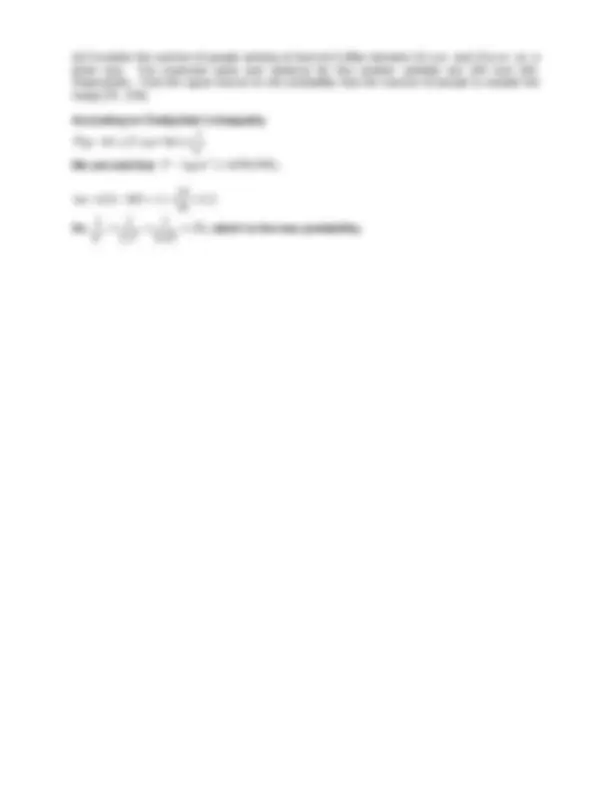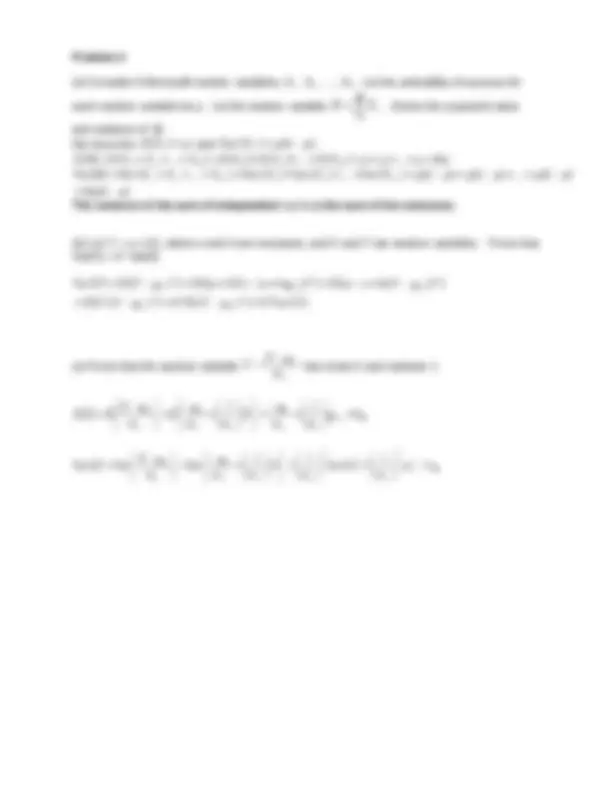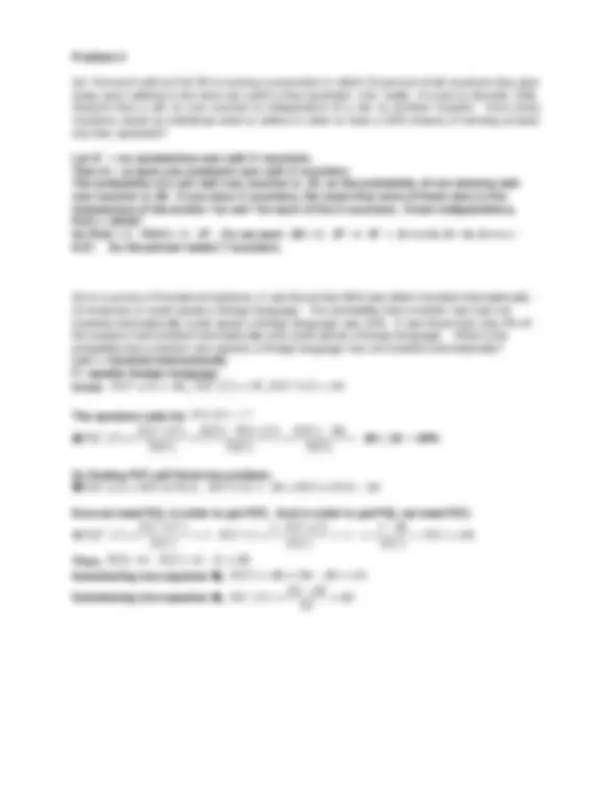





Study with the several resources on Docsity

Earn points by helping other students or get them with a premium plan


Prepare for your exams
Study with the several resources on Docsity

Earn points to download
Earn points by helping other students or get them with a premium plan
Community
Ask the community for help and clear up your study doubts
Discover the best universities in your country according to Docsity users
Free resources
Download our free guides on studying techniques, anxiety management strategies, and thesis advice from Docsity tutors
A statistics review for economics 105 students at davidson college. It covers calculating means for two datasets, variance, interquartile range, and coefficient of variation. Additionally, it includes problem-solving on probability distributions, including expected value and variance for bernoulli random variables and chebyshev's inequality.
Typology: Exams
1 / 7

This page cannot be seen from the preview
Don't miss anything!




Name:
Statistics Davidson College
Economics 105, Jan-May 2004 Mark C. Foley
Suggested Solutions
Due in class Friday.
Directions : This review is closed-book, closed-notes (except for your formula sheet) to be
taken in one sitting not to exceed 3 hours. You may use a calculator. You may not use Excel.
Perform your calculations to 3 decimal places, where necessary.
There are 100 points on the exam. Each problem is worth 25 points.
You must show all your work to receive full credit. Any assumptions you make and
intermediate steps should be clearly indicated. Do not simply write down a final answer to the
problems without an explanation.
Please turn in your formula sheet with your exam.
Carpe diem.
Honor Pledge
Start time
End time
Problem 1
Consider the following two datasets on the number of mangoes eaten per day:
Sample K: 1 2 3 5 5 5 7 8 9
Population C: 1 2 3 5 5 5 7 8 9
(a) Calculate the mean of each dataset. If different, explain why.
For sample K,
1
n
i
i mangoes
For population C,
1
N
i
i
C
mangoes
(b) Calculate the variance of each dataset. If different, explain why.
For sample K,
2
1
2 2
1
2
2
n
i
i
n
i
i
mangoes
2
2 2 2 2 2 2
1
2
2
N
i
i
mangoes
2
They are different because dividing by (n-1) instead of n, as we might expect, makes
2 2 E [ s ] , which is a desirable property (called “unbiasedness”). In other words, if we
took a really large number of samples, calculated s
2 for each of them and plotted a
histogram of all the s
2 , the mean value (expected value) would be
2
sample variance actually divided by n, call this “bad definition”
s , then^
2 2 ]
~ E [ s .
(c) Calculate the interquartile range and coefficient of variation for Sample K. Indicate your
units. Briefly explain why the coefficient of variation is useful in comparing the variability of two
or more variables.
Q 3 =¾(n+1)
th observation = 30/4 = 7.
th observation which is 7 + .5(8-7) = 7.
Q 1 =¼(n+1)
th observation = 10/4 = 2.
th observation which is 2 + .5(3-2) = 2.
Interquartile range is 7.5 – 2.5 = 5 mangoes. This is the range for the middle 50% of the
data.
mangoes
x
s CV
The coefficient of variation is useful in comparing variability of two variables because it
is not affected by the units in which those variables are measured. CV standardizes the
sample variance by the sample mean, so that the units cancel.
Problem 2
(a) Consider K Bernouilli random variables, X 1 , X 2 , …, XK. Let the probability of success for
each random variable be p. Let the random variable (^)
K
i
i
1
. Derive the expected value
We know the E^ [^ Xi ] p and Var^ [^ Xi ]^ p (^1 p ).
E B EX X X EX EX EX p p p Kp K K
1 2 1 2
1 2 1 2
Kp p
Var B Var X X X Var X Var X Var X p p p p p p K K
The variance of the sum of independent r.v.’s is the sum of the variances.
(b) Let Y = a + bX, where a and b are constants, and X and Y are random variables. Prove that
Var[Y] = b
2 Var[X]
2 2 2 2 2
2 2 2
Eb X bE X bVar X
VarY E Y E a bX a b E a a b X
X X
Y X X
(c) Prove that the random variable
X
X
X X
X
X X
X
X
X
2
2 2
X
X X X X
X
X
X Var X VarX
Problem 3
(a) Ferrucci’s deli at Exit 28 is running a promotion in which 10 percent of all vouchers they give
away upon walking in the store are worth a free sandwich (not really; it’s just my favorite deli).
Assume that a win on one voucher is independent of a win on another voucher. How many
vouchers would an individual need to collect in order to have a 50% chance of winning at least
one free sandwich?
Let A’ = no sandwiches won with X vouchers.
Then A = at least one sandwich won with X vouchers
The probability of a win with one voucher is .10, so the probability of not winning with
one voucher is .90. If you have X vouchers, the event that none of them wins is the
intersection of the events “no win” for each of the X vouchers. Given independence,
X .
So P(A) = 1 – P(A’) = 1 -.
X
. So we want .50 = 1 -.
X .
X = .5 x ln .9 = ln .5 x =
6.57. So the person needs 7 vouchers.
(b) In a survey of investment bankers, it was found that 46% had either traveled internationally
on business or could speak a foreign language. The probability that a banker who had not
traveled internationally could speak a foreign language was 10%. It was found that only 4% of
the bankers had traveled internationally and could speak a foreign language. What is the
probability that a banker who speaks a foreign language has not traveled internationally?
Let I = traveled internationally
F= speaks foreign language
The question asks for P (^ I F )?
So finding P(F) will finish the problem.
Now we need P(I), in order to get P(F). And in order to get P(I), we need P(I’).
Substituting into equation , P (^ F ).^46 .^04 .^40 .^10
Substituting into equation ,.^60
. 10
Problem 4
Assume that the distance an inconsistent decathlete throws the javelin is distributed as a
uniform random variable with positive probability density between -10 and 75 meters.
(a) Write the complete formulas for and draw properly-labeled graphs of the probability density
function and cumulative probability density function for the distance of javelin throws.
otherwise
x f x 0 ,
1 / 85 , 10 75 ( )
(^) ^
1 , 75
, 10 75
0 , 10 ( ) 8510
x
x
x F x bx a^ a x
(b) The women’s world record in the javelin throw was set on July 1, 2001 by Osleidys
Menendez of Cuba at 71.5 meters. What is the probability this inconsistent decathlete breaks
the record?
P ( 71. 5 x 75 ) F ( 75 ) F ( 71. 5 )[ 1 ( 71. 5 10 )/ 85 ][ 1 . 9588 ]. 0412
(c) Find the expected value of the distance squared.
75 ( 1000 ) 1658. 333
85 * 3
1
85 3
1 [ ] ( ) ( )
3
75
10
(^753)
10
85
(^2 )
x E X x f xdx x f xdx x dx
b
a
(d) Find the variance of the distance.
2
10 75
2
[ ] [ ] 1658. 333
2 2
2 2
^
a b Var X E X X
F(x)
-10 75 x
1
0
f(x)
x
-10 75
1/